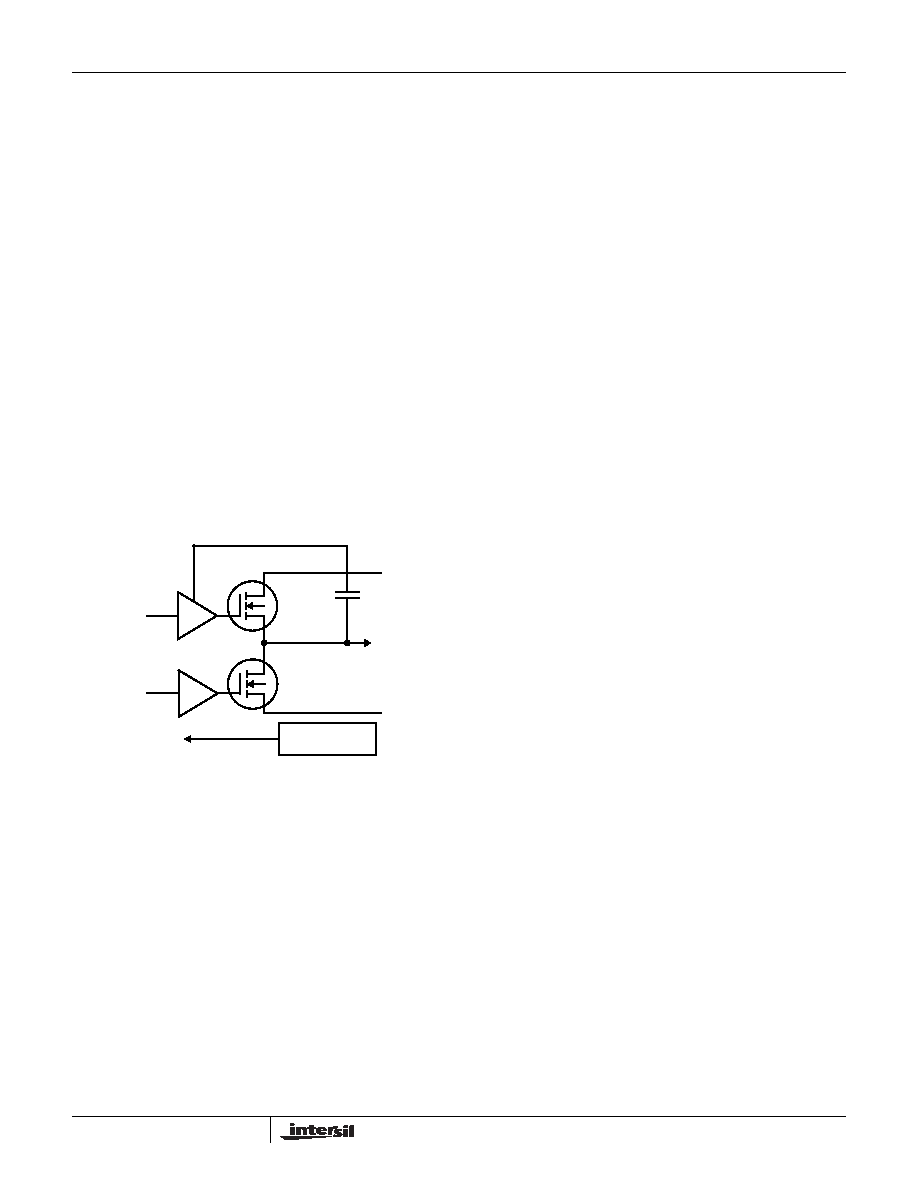- 您現(xiàn)在的位置:買(mǎi)賣(mài)IC網(wǎng) > PDF目錄2067 > D2-24044-MR (Intersil)IC DGTL AMP AUDIO PWR D 38HTSSOP PDF資料下載
參數(shù)資料
| 型號(hào): | D2-24044-MR |
| 廠商: | Intersil |
| 文件頁(yè)數(shù): | 2/20頁(yè) |
| 文件大?。?/td> | 0K |
| 描述: | IC DGTL AMP AUDIO PWR D 38HTSSOP |
| 標(biāo)準(zhǔn)包裝: | 50 |
| 系列: | D2Audio™ |
| 類(lèi)型: | D 類(lèi) |
| 輸出類(lèi)型: | 2-通道(立體聲)或 4 通道(四路) |
| 在某負(fù)載時(shí)最大輸出功率 x 通道數(shù)量: | 30W x 2 @ 8 歐姆 |
| 電源電壓: | 9 V ~ 26 V |
| 安裝類(lèi)型: | 表面貼裝 |
| 供應(yīng)商設(shè)備封裝: | 38-HTSSOP |
| 封裝/外殼: | 38-TFSOP (0.173",4.40mm 寬)裸露焊盤(pán) |
| 包裝: | 管件 |
第1頁(yè)當(dāng)前第2頁(yè)第3頁(yè)第4頁(yè)第5頁(yè)第6頁(yè)第7頁(yè)第8頁(yè)第9頁(yè)第10頁(yè)第11頁(yè)第12頁(yè)第13頁(yè)第14頁(yè)第15頁(yè)第16頁(yè)第17頁(yè)第18頁(yè)第19頁(yè)第20頁(yè)

10
FN7678.0
September 3, 2010
Functional Overview
The devices include four independent output stages
(Figure 9) that are each implemented using a high side
(to positive VDDHV supply) and a low side (to HV supply
ground) FET pair. Drivers and overcurrent monitoring are
included in each of these four output stages. Depending
on the selected configuration mode, these four stages
can be used independently as single half-bridge outputs,
or as pairs for full-bridge outputs.
Digital PWM inputs are connected to the PWM input pins,
where their signals are routed through the configuration
select logic to the individual output FETs and drivers.
On-chip temperature and undervoltage monitoring, and
individual per-output current monitoring provides
protection and status reporting outputs to the system
controller.
Upon application of power, the on-chip voltage sensors
monitor presence of the required power voltages. Until all
voltages are at their design specifications, the outputs
remain off and floating.
After supply voltages are within limits and stable, the
output configuration is set by the logic levels at the
OCFG0 and OCFG1 input pins, and the PWM inputs are
routed to their appropriate output stage FETs.
Output Options
The D2-24044 devices provide four configuration options
for the outputs. These options are selected by strapping
the OCFG0 and OCFG1 pins high or low. These defined
configurations include:
2 Channels of Full Bridge, 4-Quadrant Outputs,
2 Channels of Full Bridge, 2-Quadrant Outputs
4 Channels of Half-Bridge Outputs
2 Channels Half-Bridge, Plus 1 Channel Full Bridge
When a configuration is set that includes a full-bridge
output, each input channel’s PWM input signal is routed
to the high and low side FETs, appropriate for that full
bridge operation. Note however, that the device can be
configured as 4 independent half-bridge outputs (using
mode “11” as described in the configuration assignment
table on page 14) and two of those outputs can be used
in a full bridge configuration, simply by connecting the
appropriate PWM input pins to the input source. This
allows flexibility in applications where combinations may
be desired other than the four defined by the output
configuration modes.
Power Supply Requirements
The device operates from two supply voltages:
PWMVDD is a nominal 3.3V supply voltage, and
operates the logic and control.
HVDD (HVDD[A:D], and VDDHV) is the “high
voltage” used for operating the output power stages.
Individual HVDD and its ground (HGND) pins are
included for each of the four power stage outputs,
providing channel isolation and low impedance source
connections to each of the outputs. A separate VDDHV
pin is used for the output drivers, and is the source for
the on-chip regulated 5V source needed for the drivers.
All the HVDD/VDDHV pins connect to the same voltage
source.
PWMVDD is the reference for the PWM inputs and device
control logic, and is the same voltage as used by the
PWM/system controller.
High Side Gate Drive Voltage
An on-chip bootstrap circuit provides the high-side gate
drive voltage used by each output stage. A pin is
included for each output channel (HSBS[A:D]) for
connection of a capacitor (nominal, 0.22μF/50V) from
this pin to that channel’s PWM output. The charge
pumping actions uses this capacitor to filter and hold this
gate drive voltage, and enables amplifier operation
without need of connection to an additional power supply
voltage.
Supply Bypass Connection
Power supply bypass capacitors should be connected
across each of the power supply connection pins, as:
Four HVDD power pins and their respective HGND
ground pins. These should be a parallel combination
of a nominal 100μF and 0.1μF capacitors, located as
close as possible to the HVDD/HGND pin pair.
A 0.1μF capacitor also is to connect at the VDDHV
pin.
The PWMVDD power pin should include a 1μF and
0.1μF capacitor.
REG5V
The on-chip gate drive power supply operates from the
VDDHV power input, to produce the 5V supply voltage.
The REG5V pin is used for external capacitor connection
to filter this regulated voltage. A 1.0μF and 0.1μF
capacitor should be connected to this pin, and the
connection should be made as close as practical to the
pin. No other connection is to be made to this pin.
FIGURE 9. OUTPUT STAGE
HSBSA
HIGH-SIDE
PWM DRIVE
LOW SIDE
PWM DRIVE
nERROR
OVERCURRENT
HGND
(GND)
LOW
SIDE
FET
HIGH
SIDE
FET
(+)
HVDD
OUT
D2-24044
相關(guān)PDF資料 |
PDF描述 |
|---|---|
| D2-45157-QR | IC DGTL AMP PWM CTRLR 68QFN |
| DS1080CLU+ | IC CRYSTAL MULTIPLIER SS 8-MSOP |
| DS1080LU+A00 | IC CRYSTAL MULT SS 8-USOP |
| DS1085LZ-12+ | IC ECONOSCILLATOR SYNTH 8-SOIC |
| DS1085Z-25+ | IC ECONOSCILLATOR SYNTH 8-SOIC |
相關(guān)代理商/技術(shù)參數(shù) |
參數(shù)描述 |
|---|---|
| D2-24044-MR-T | 功能描述:音頻放大器 LW-PWR CLASS-AMPLIFI 3 8LD HTSSOP 4 4X9 7 RoHS:否 制造商:STMicroelectronics 產(chǎn)品:General Purpose Audio Amplifiers 輸出類(lèi)型:Digital 輸出功率: THD + 噪聲: 工作電源電壓:3.3 V 電源電流: 最大功率耗散: 最大工作溫度: 安裝風(fēng)格:SMD/SMT 封裝 / 箱體:TQFP-64 封裝:Reel |
| D224E | 制造商:MPD 制造商全稱(chēng):MicroPower Direct, LLC 功能描述:Low Cost, 2W SIP Single & Dual Output DC/DC Converters |
| D224ED | 制造商:MPD 制造商全稱(chēng):MicroPower Direct, LLC 功能描述:Very Low Cost, 2W SIP Dual Isolated Output DC/DC Converters |
| D224EI | 制造商:MPD 制造商全稱(chēng):MicroPower Direct, LLC 功能描述:Low Cost, 2W SIP High Isolation DC/DC Converters |
| D224ERW | 制造商:MPD 制造商全稱(chēng):MicroPower Direct, LLC 功能描述:Low Cost, Miniature 2W SIP, Wide Input DC/DC Con vert ers |
發(fā)布緊急采購(gòu),3分鐘左右您將得到回復(fù)。